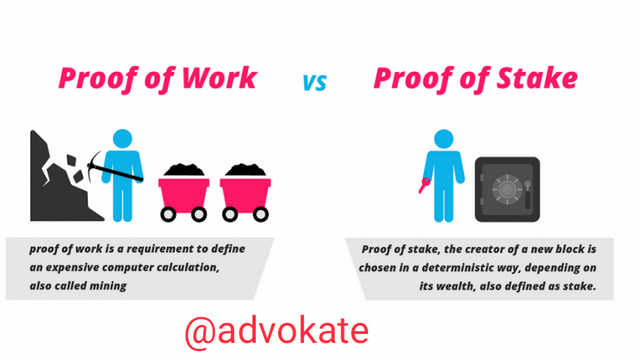Steemit Crypto Academy Season 4 - Homework Post for @sapwood | Task 6: Different types of Consensus Mechanism.

(1) What is the difference between PoW & PoS? Advantages & Disadvantages? Which one is better in scaling Capacity? Examples?

INTRODUCTION

Cryptocurrency owe all their success to their various consensus mechanisms, most cryptocurrency consensus mechanism falls under the category of Proof of Work and Proof of Stake. Each of these two have their disadvantage and advantages
Meanwhile to understand the concept of proof of work and proof of stake, you needs to be familiar with what the concept Consensus Mechanism in Cryptocurrencies.
CONSENSUS IN CRYPTOCURRENCY - is a coming together to an agreement whether a transaction is valid or not. Usually when a consensus threshold is more than half or 51%, the system is said to have reached on a consensus. Cryptocurrency consensus mechanism features built-in financial incentivize that make ensures that only valid transactions are confirmed.
Using this as an illustration - A group of 11 friends deciding to go for shopping or movie and the majority vote determine where you will go which would be the 6 out of 11 and it looks like it's the movie and you don't want to go to the movie and you realize that you are about to lose the majority vote, you come up with a clever ideas by inviting two of your friends to join the other of your friends to the side where you all are hanging out and those your three added friends said they want to go to shopping and the majority vote has swung in favour of you by 7 to 6, so the majority have decided where to go because the majority win. This is known as consensus, this same risk of consensus manipulation is also present in cryptocurrency blockchain, the difference is that the participants on the blockchain are deciding to approve millions of transactions, so stake are more higher. This creates a huge incentive for someone to connect additional computers to a cryptocurrency blockchain to manipulate this transaction to their benefit like you did by adding two other friends to reach consensus on where to go. Although the more computers is connected to a network, the more secured it is, especially if they are distributed around the world. To incentivise computer connected to cryptocurrency network to validate transaction properly, Proof of stake and Proof of Work are how most cryptocurrency achieve this goal.

PROOF OF WORK

Proof of work is a kind of consenasus mechanism in which uses a high computing power and energy to process a transaction on proof of work Blockchain like bitcoin where the computer need to make a correct guess of extremely random number in other to own the right to do so and this cause time and energy do to this. To incentivize to join Proof of Work cryptocurrency blockchain, they own fees from the transaction in each block plus a block reward in that cryptocurrency native coin example bitcoin. Bitcoin adjust its network difficulty based on how much computing power is connected to it, this is to avoid super computers not to always guess the random number before anyone.

PROOF OF STAKE

In Proof of Stake, instead of using large amount of computing power and energy to process a transaction, a cryptocurrency is staked (locked) on the blockchain, The length of time a cryptocurrency must be staked to process a transaction can vary as can the minimum amount of coin must locked up as a stake, that is the more cryptocurrency staked, the more likely you are to process a transaction and create a block.
An amazing feature employed in Proof-of-Stake mechanism which makes it somehow secured is known as SLASHING, basically if a computer tries to break the rule of some of the blockchain in some way, some of the cryptocurrency they staked will be destroyed. In Proof of Stake, if you don't have time to run your computer every hours of the day or you don't have the minimum stake to join the required network, you can lend your coin to other computers to earn some part of their reward.

THE DIFFERENCE BETWEEN PROOF OF WORK (PoW) & PROOF OF STAKE (PoS)
| PROOF OF WORK | PROOF OF STAKE |
|---|---|
| 1. PoW requires large amount of computing power hardware like Application Specific Integrated Circuit Machine (ASIC) and energy to perform transaction, because mining of new coins take a lot of computing power as it needs to make a correct guess of extremely random numbers in other to get it right and earn a reward from fees of the transaction and the reward in that cryptocurrency native coin | POS requires less amount of computing power and energy in other to stake and stand a chance to be the next block validator, this makes proof-of-stake system much more cost and energy efficient than proof of stake as it works on a system that the higher you stake the higher you gain. This is the reason behind why it's called a rich man game. |
| 2. In Proof of Work, the selection of miner is extremely random and it ensures greater degree of decentralisation | In Proof of Stake, the block creator is chosen based on proportion of their stake, which means that the higher you stake, the higher you stand a better chance to be the block validator. |
| 3. Proof of Work is not that fast compared to PoS because most computing power goes to guessing random number and not actually processing transaction, this slower the block time and block size in PoW which means that the size of their Blockchain is generally smaller than PoS cryptocurrency, this makes it easy for someone to run nodes which stores full transaction history of a cryptocurrency blockchain. This nodes play a key role in decentralization of cryptocurrency like Bitcoin and Ethereum | PoS is more efficient in processing a transaction, most PoS cryptocurrencies are much more faster than most PoW cryptocurrencies, also they have block size that are multiple times larger than the bitcoin blockchain, this is because most POS cryptocurrencies do not require computer connected to them to store entire transaction history instead most of them rely on cloud storage to store their full blockchain history. |
| 4. Proof of Work operate an a fair lodge where the community collectively mine the cryptocurrency from zero. | Most proof of stake cryptocurrencies have what we call Pre-mine pool which is where majority of the token are minted in advance and distributed to the investors and the team. |
| 5. The long-term success of proof-of-stake cryptocurrency depends on Application of Specific Integrated Circuit(ASIC) resistance and the cost of energy. | The long-term success of proof-of-stake cryptocurrency depends on equitable distribution of supply and the ability to store massive transaction history. |
| 6. Proof of Work are decentralised and more secured than Proof of Stake | Proof of Stake are centralised and less secured. |
| 7. Only the first miner that solves or guess the correct random number can validate the block and get the reward. | The validator of the block in proof of Stake gets the network fees as their rewards. |
| 8. Example of coins that makes use of Proof of Work consensus mechanism are; Bitcoin (BTC), Ethereum (ETH), Monero, Dogecoin, Bitcoin Cash, Litecoin. | Example of some coins that makes use of Proof of Stake consensus mechanism are; Cardano, Algorand, Solana, Validity, Vega Protocol, Tezos. |

ADVANTAGES & DISADVANTAGES OF PROOF OF WORK?

| ADVANTAGES OF PoW | DISADVANTAGES OF PoW |
|---|---|
| 1. Since proof of work is decentralised, it offers benefit such as trust, transparency and security, all blocks represent a ledger of transaction. | Proof of Stake uses and election process in which only one load is chosen to validate the next block. The mining pool controls large portion of the blockchain, they centralized the mining process which makes it dangerous for the system. |
| 2. Proof of Work is more resilient to manipulation because it's hard to buy the hardware do to so especially with thousands of nodes keeping the track of the real transaction history. | For many years many company have developed a specialised computer machine called ASIC, this machine is quite expensive, and it's specifically designed to perform only PoW applications, the probability of mining bitcoin with a single ASIC is very slim unless your are willing to spend millions of dollars for mining operation, when a new ASIC model is released, the older model ends up in a land fill because this machine can not perform any other function apart from mining bitcoin and this gives environmental concerns about PoW cryptocurrency mining. |
| 3. Proof of Work is used to validate transaction, building and maintaining subsequent blockchain thereby giving you the ability to think smart. | The precedings of proof of stake in mining cryptocurrency like bitcoin causes widespread of power outage since miners goes to where power is cheap to subsidize cost. This comes to be issue when it causes energy shortage as it occurred in country like Iran. |
| 4. In guessing and solving the complex mathematical puzzles in other to validate a block, only the winning miner get rewarded in the native cryptocurrency example bitcoin rewards the winning miner with 12.5BTC (as of the time of making this post) | guessing and solving complex mathematical puzzles is time consuming and at the end of it, only the winning miner gets the reward and the rest of the miners gets nothing as reward. |

ADVANTAGES AND DISADVANTAGES OF PROOF OF STAKE.

| ADVANTAGES | DISADVANTAGES |
|---|---|
| 1. The staking process makes it easy to create an online chain governance system that allows stakers to vote on how cryptocurrency should be changed. | most the proof of stake cryptocurrencies are most centralised than ethereum and bitcoin,this is because the average users only option is to join this taking pool. |
| 2. Proof of stake is much faster, cheap and energy efficient in processing a transaction. there is no computation requirement to fork a chain in Proof of Stake. You can generate the chain in a matter of minutes without costing you much financially. | There is lack of security resulting in to weak subjectivity, there is no way for a new node to tell for which one is the main chain without trusting someone to tell you which one is the main chain and this is against the decentralized concept. This is same as the node that have been offline for a long time they don't know which one is the main chain either. |
| 3. Proof Of Stake have a bigger blockchain size that are multiple times larger than that of the bitcoin blockchain. This is because most proof-of-stake cryptocurrency do not require the computers connected to them to store the entire transaction history, instead most of them rely on cloud storage to store full their are full blockchain history. | Since proof of stake cryptocurrency are centralised and their governance process makes things worst, the larger the stake cryptocurrency blockchain the more value bad actors would stand to gain. |
| 4. Proof of Stake is an alternative to proof of work. PoS makes any 51% attach more expensive. | If an actor buys majority of the stake in the network he can effectively control it and approve transactions to harm the system, this is known as 51% attack. |
| 4. Proof of stake employs a system known as Slashing as a penalty to bad actors that is trying to corrupt the system, this is a way some Proof of Stake cryptocurrency protect their blockchain from manipulation. | Most cryptocurrencies in Proof-of-Stake do not have slashing system enabled as a penalty when a bad actor tries to manipulate the system. |

BETWEEN PoW and PoS, WHICH IS BETTER IN SCALING CAPACITY? EXAMPLES?

Neither of these two consensus mechanism is perfect but for me, Proof of Stake is preferred over Proof of Work because of some benefits which Proof of Stake consensus mechanism offers in terms of performing high transaction per second, less engery consuming and less expensive computing hardware used by Proof of Stake.
Examples are;
1. ALGORAND (ALGO)-

Src
Algorand is one of the cryptocurrencies that operates on Proof of Stake consensus mechanism to validate a transaction in which the cryptocurrency is said to be scalable efficient as it handles 1000 transactions per second with a block close time of approximately 5 seconds.
2. CARDANO (ADA)-

Src
Cardano is an open project that is built to redistribute power from structures that are not accountable which helps to provide a secured, transparent and fair society. The Cardano blockchain is capable of handling 257 transaction per seconds.
3. SOLANA (SOL) -

Src
Solana is built to aid decentralized app (DApp) creation. This operate on two consensus mechanism known as Proof of History and Proof of Stake consensus mechanism which makes it have a very short processing time. Solana support 50,000 transaction per seconds.
4. Stellar Lumens (XLM) -

Src
Stellar Lumens is a network that is open to allow money to be moved and stored, the aim of this network is to help financial organisations connect through blockchain technology. Stellar Lumens support about 250 transactions per seconds.

CONCLUSION

Apart from Proof of Stake and Proof of Work, there are also other consensus mechanisms that is used by other cryptocurrencies to validate transaction which are;
- Delegation of Proof of Stake.
- Proof of Capacity.
- Proof of Elapsed Time.
- Proof of Identity.
- Proof of Authority.
- Proof of History.
- Practical Byzantine Fault Tolerant (pBFT)
- Proof of Burn.
There are still other kind of consensus mechanism but none of them is perfect, they all have their advantages and disadvantages in carrying out their operations.
Furthermore, Proof of Work and Proof of Stake happens to be more popular because most cryptocurrencies falls under this category.

Cc;
@sapwood
@nane15
@xkool24
@whitestallion

It contains plagiarized content.
Original Source: https://medium.com/general_knowledge/proof-of-work-vs-proof-of-stake-beginners-guide-da257533be8
Thank you.
Cc: @dilchamo